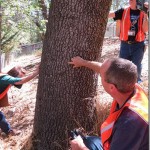
Photo by Edwina Scott
The Mountain Communities Fire Code Committee heard from San Bernardino County officials and the public last week in the first of its meetings open to audience members.
“Today, the San Bernardino people will tell us about how they implement their program,” said Cal Fire Battalion Chief Charlie De Hart, law enforcement and investigations, and committee chair.
Gregg Torrance of the San Bernardino County Fire Hazard Abatement group emphasized that abatement regulations are applied throughout the county, including undeveloped properties in its mountain communities. However, there are limits to what his staff can accomplish.
“We conduct mostly windshield surveys. We have seven inspectors and more than 43,000 notices,” he explained. “We have to be able to see [a violation] unless there is a complaint [about the property].”
About 10 percent of the notices result in action, he stated. After a notice of violation is mailed, they conduct a second inspection. If the hazards are removed, there are no fees. If the hazards are still present, a $124 administrative fee is applied and a third inspection conducted. At least a 30-day period falls between inspections.
For properties with a dwelling or structure, a $126 warrant procurement fee may also be charged and if necessary, they will seek a work order to have a county contractor do the abatement. This can cost up to $351 per hour depending upon the contractor.
If the property owner does not pay for the abatement costs, Torrance said a lien is placed on the property. Owners can appeal to a special board, not the courts, and there is a charge for the appeal.
Examples of the violations include weeds and grass taller than 4 inches; pine needles, cones or leaf litter more than 2 inches in depth; and dead trees.
He stressed that abatement is enforced within 100 feet of structures, including neighboring lots, even if they are vacant. “Whoever owns the property has to clean or gets a notice,” he affirmed. A description with pictures of how to create defensible space is available at www.readyforwildfire.org/defensible_space.
Warren Faurot, a member of the public attending the meeting, asked, “If abatement reduces the value of a property, has that ‘taking’ been tested in court?” None of the meeting participants were aware of any court cases addressing this question, although they believed that the necessary abatement should reduce the risk of fire and therefore improve the property.
If fire agencies can adequately implement and enforce the state’s public resource code (4291) for defensible space, Marge Muir of Pine Cove suggested that vacant lots might be addressed within the community.
And Scott Fisher of Pine Cove asked why any enforcement needed to change. “It’s already working and [these actions] won’t change any fire-insurance rating. That’s largely based on the proximity to the national forest and state lands.”
Fire threats can emanate miles away, not just from adjacent lots, Fisher said, and referred to the numerous fire brands that floated miles during the Mountain Fire.
However, De Hart replied that firefighters’ safety was another important criterion.
Before the meeting ended, De Hart stressed that the committee was still evaluating the issues and possible solutions and would meet again with County Fire Chief John Hawkins.
“We don’t want to change the environment. We just want to reduce the levels of fire threat that create hazards,” said Riverside County Fire Inspector Joe Lewis. “Defensible space is not moon-scaping. It’s also removing hazard to you, firefighters and law enforcement.”
Some Pine Cove residents confront committee
As the latest Mountain Communities Fire Code meeting began, Pine Cove residents Norm Cassen and wife, Shari, expressed their disappointment and objection about how the process has evolved.
“It’s an insult to the community that the only group represented is the Mountain Communities Fire Safe Council,” Shari said. She and her husband urged representation from local businesses, especially the real estate industry, and other volunteer groups with large memberships.
Then Norm accused MCFSC of a conflict of interest, charging them with gaining a financial interest with each property abated.
In fact, MCFSC seeks grant funds to perform the numerous projects on the Hill, including the wood-shake shingle replacement. Funding agencies usually require some matching contribution from the property owner.
Besides reviewing abatement contractors, MCFSC will oversee the contracts and ensure abatement occurs within the current county regulations. This staff is paid and a portion of grant funds covers these costs.
Norm also accused the county of using the fire code implementation to “build a cadre of inspectors.” This staff would be paid for from money such as the state fire prevention fee.
The committee had been waiting to hear about the San Bernardino County program since December. Twice, a meeting was scheduled, but the San Bernardino officials had to postpone because of weather conditions and other reasons. Nevertheless, Norm admonished the committee for canceling those meeting and implied the reason was lack of openness.









